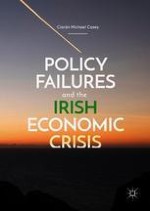2018 | OriginalPaper | Buchkapitel
4. Domestic Organisations
verfasst von : Ciarán Michael Casey
Erschienen in: Policy Failures and the Irish Economic Crisis
Aktivieren Sie unsere intelligente Suche, um passende Fachinhalte oder Patente zu finden.
Wählen Sie Textabschnitte aus um mit Künstlicher Intelligenz passenden Patente zu finden. powered by
Markieren Sie Textabschnitte, um KI-gestützt weitere passende Inhalte zu finden. powered by
